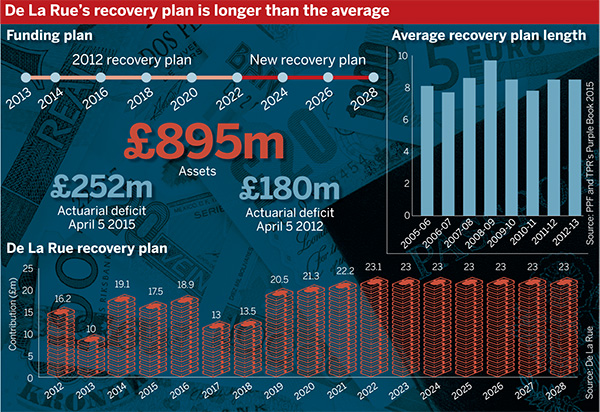Banknote and passport printer De La Rue has agreed an extended recovery plan with its pension scheme trustees after its most recent actuarial valuation showed an increased deficit of £252m.
Low gilt yields have been putting pressure on schemes, pushing up liabilities and in many cases forcing sponsoring employers to agree to increased contribution plans to fill the gap.
Earlier this month, the company announced a revised funding plan, which aims to plug the deficit over 12 years from March 31 2017, extending the earlier plan that started in 2013 and had been intended to eliminate the deficit by 2022.
It’s more time, so they are exposed to a greater risk on the funding side because of the recovery plan
Richard Smith, Spence & Partners
In a statement accompanying the announcement, De La Rue’s chief financial officer Jitesh Sodha said the agreement would allow the scheme “to reduce risk in the investment strategy, which should result in lower volatility in the scheme”.
Longer plan prompts investment risk reduction
A spokesperson for the company said the scheme had reduced its equity allocation to 25 per cent from 35 per cent, and its diversified growth fund allocation to 20 per cent from 22 per cent as a result, with the balance going into bonds.

The spokesperson added that the increased deficit was also largely a result of a lowering in the discount rate. This has been seen across many pension schemes in recent months.
“A quarter of a per cent increase in the discount rate would reduce the deficit by £50m,” the spokesperson said.
Often schemes will look to increase their allocation to higher-risk assets such as equities when they get improved guarantees from their sponsoring employer; the increased support allows them to pursue greater levels of return by shouldering higher levels of risk.
The De La Rue scheme has done the opposite.
However, Richard Smith, head of trustee advisory at consultancy Spence & Partners, said where a recovery plan increases in length, trustees can become more cautious.
“From the trustee’s perspective the starting point would be they need to take into account the integrated risk of the company,” he said. “Typically they will be in a situation where the less risk they take the better, as it means the less reliance on the company.”
Reliance on sponsor increases
He added that the trustees could view the scheme as being at greater risk because of the increased timescale for them to reach full funding.
“It’s more time, so they are exposed to a greater risk on the funding side because of the recovery plan. They are relying on the company to be around and pay those contributions for more years.”
In the case of De La Rue, this dependence has been extended by six years.
Where trustees are facing the prospect of a long road to full funding, Smith said they may seek to reduce their investment risk in exchange for the increased funding risk.
“Taking more risk would typically be driven by the company, and in order to persuade the trustees to take more risk they would seek something in return,” he said.
“It illustrates the flexibility that trustees and companies have together when approaching valuation deficits and the importance of both sets taking action and working collaboratively.”
Ben Roe, partner at consultancy Aon Hewitt, said any investment changes following alterations to a recovery plan would rely heavily on the circumstances of a scheme.
“It’s very scheme-specific. It depends on the strength of employer covenant and views of how much risk they’re willing to take,” he said.














